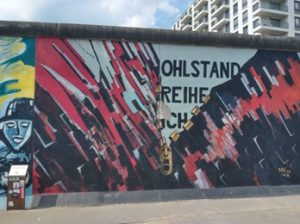
This is a photo of the Berlin Wall that I took in 2019. The wall was built in 1961 and demolished in 1989. While the Berlin Wall is best known for its political and social consequences, it also had significant economic consequences in both East and West Germany.
Economically, the Berlin Wall created two distinct systems with opposing economic ideologies. West Berlin, as part of West Germany, thrived under a market-based capitalist economy, benefiting from economic integration with Western Europe and the United States. The region attracted investments, experienced high productivity, and enjoyed a higher standard of living.
East Berlin, which was part of East Germany, on the other hand, had a centrally planned socialist economy. It was plagued by chronic economic stagnation, a scarcity of consumer goods, and a lack of economic opportunities. Because of a lack of incentives and the absence of a free market system, state-controlled industries struggled to compete globally, and innovation was stifled.
The fall of the Berlin Wall in 1989 marked a watershed moment in German history. In the former East Germany, the transition process included privatisation and infrastructure development. East Germany, on the other hand, struggled to catch up with economic prosperity.






